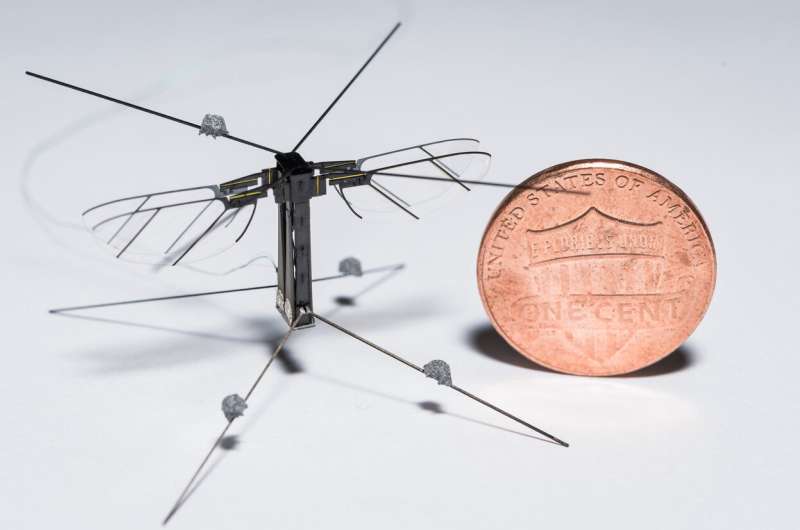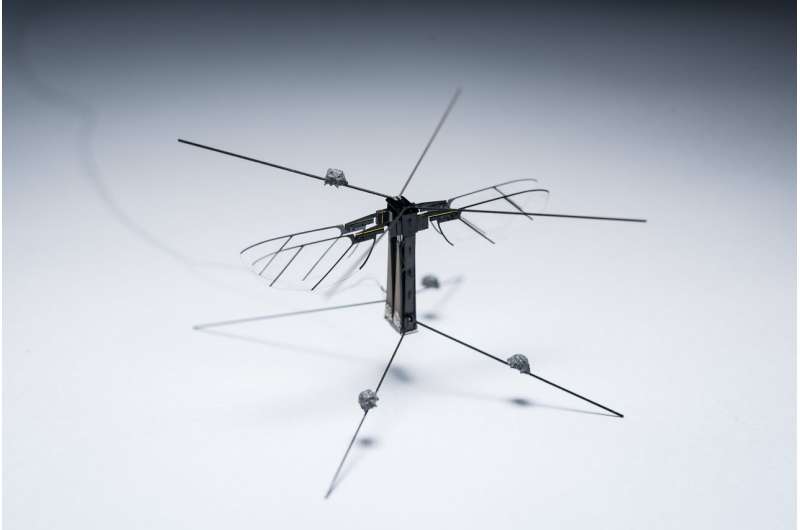November 14, 2019 feature
A unifying approach for controlling flying robotic insects

One of the key problems confronting researchers in the field of microrobotics is designing and implementing reliable controllers for insect-scale micro air vehicles (FWMAVs), which are tiny flying robots typically inspired by insects. In fact, although these insect-size robots could have numerous useful applications, for instance, assisting humans in search and rescue missions or in agriculture, developing controllers that match their size and structure has so far proved to be difficult.
Researchers at the University of Southern California (USC) have recently carried out a study exploring the challenges in designing these controllers. In their paper, prepublished on arXiv, they introduce a new unifying approach that could inform the development of more effective techniques for the control of FWMAVs. The researchers behind the study are part of the autonomous microrobotic systems laboratory (AMSL), which is the inheritor of a research line that started at UC Berkeley more than 20 years ago, continued at Harvard from 2005 and arrived at USC in 2013.
"We, as a team, share the same dream of many in the microrobotics community; the vision of creating fully autonomous artificial insects that can operate intelligently in highly unstructured environments," Prof. Nestor O Perez-Arancibia, the principal investigator (PI) for the study, told TechXplore. "Personally, I am inspired by nature. Our machines, including Bee+, which is an amazing piece of engineering, still lag behind real insects in terms of aerobatic capabilities, actuation, sensing, computational power, etc."
Perez-Arancibia has been conducting research into microrobotic systems for several years. He believes that all human-made machines could ultimately be improved if drawing inspiration from nature, for instance by observing and replicating the behaviour or characteristics of bees, butterflies and mosquitos.

In their study, Perez-Arancibia and his colleagues investigated the control of flying insects using two different experimental platforms: a Bee-like two-winged robot and the four-winged Bee+ micorobot developed at USC. In a series of experiments, they were able to demonstrate that a technique that employs quaternion coordinates for attitude control, which is designed to control unmanned vehicles with four rotors, can be applied to drive both these robotic insects.
"We were able to simplify something that many researchers see as very difficult," Perez-Arancibia said. "I like to believe that this is an instance in which intelligent modeling (i.e., by looking at the problem from a new and 'better' perspective), we can understand and analyze seemingly intractable complex phenomena that can help us to develop better robotic designs, especially in terms of aerodynamic force generation, mechanism configuration and actuation."
The results of the tests carried out by Perez-Arancibia and his colleagues suggest that the generic strategy they introduced could be used to control different types of artificial insects that share some common characteristics. While they specifically demonstrated the effectiveness of this strategy on a two-winged robot and the four-winged Bee+ robot, it could potentially also be applied to other insect-like microrobots.
Perez-Arancibia believes that by following a high-level control approach that decouples the problems of actuation and flight control, it is possible to identify general algorithms that can be employed in multiple platforms. For instance, this approach could allow researchers to develop new algorithms for aerobatic flight employing 19-gram quadrotors that could subsequently be implemented on a 95-milligram, four-winged Bee+.
"This is relevant because as robotic flyers become smaller, they also become harder to fabricate, more difficult to handle and more expensive," Perez-Arancibia said. "Consequently, as shown in our paper, the fact that the same approach can be employed to synthesize controllers for platforms with weight differences as large as two orders of magnitude is significant and relevant from both research and practical perspectives."
In the future, the approach introduced by this team of researchers at USC could inform the design and implementation of new controllers for insect-like microrobots. In addition, over the next few months, Perez-Arancibia and his colleagues will be working on a different project aimed at creating the very first fully autonomous sub-gram flying artificial insect.
"Currently, the main limitation that has prevented microroboticists from achieving autonomous flight at the sub-gram scale is the extremely low energy densities of electric batteries," Perez-Arancibia said. "We will achieve autonomy by employing artificial muscles powered by catalytic reactions."
More information: Control of flying robotic insects: a perspective and unifying approach. arXiv:1910.11911 [cs.RO]. arxiv.org/abs/1910.11911
© 2019 Science X Network



















